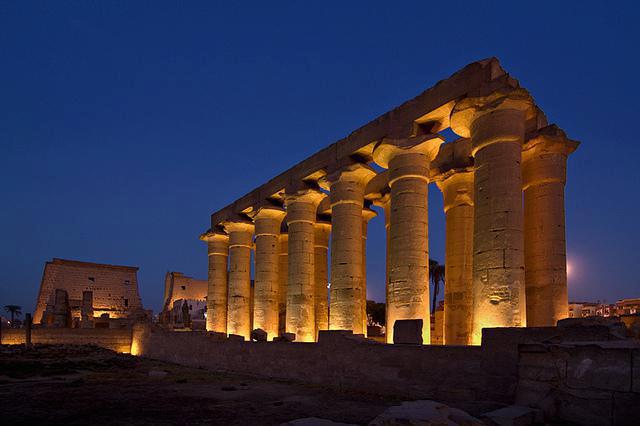Luxor Greatest Temple: Facts, Plan, Architecture & History
Step into the world of ancient Egypt as you explore the enchanting Luxor Temple, a remarkable architectural masterpiece that stands as a testament to the grandeur and splendor of the New Kingdom. In this comprehensive guide, we will delve into the fascinating history, captivating features, and cultural significance of Luxor Temple, offering you a unique insight into this iconic landmark.
Ancient History Unveiled
Luxor Temple has a rich and storied past, steeped in myth and history. Let's explore its intriguing background:
Religious Significance: Luxor Temple was dedicated to the divine triad of ancient Egyptian gods—Amun-Ra, Mut, and Khonsu. It served as a cult center and a site for important religious ceremonies and festivals, attracting pilgrims and worshippers from all over ancient Egypt.
New Kingdom Legacy: The construction of Luxor Temple began during the reign of Amenhotep III and continued through subsequent pharaohs, including Tutankhamun, Ramses II, and Amenhotep IV (Akhenaten). Each ruler added their own touches and expanded the temple complex, leaving behind a legacy of architectural marvels.
Symbolism and Purpose: Luxor Temple represented the earthly abode of the gods and played a significant role in the concept of divine kingship. It was believed that the pharaoh, as the intermediary between the gods and the people, would receive blessings and divine guidance in the temple, ensuring harmony and prosperity for the kingdom.
The Architecture of Splendor
Luxor Temple's architectural design and exquisite craftsmanship are a testament to the skills and ingenuity of ancient Egyptian artisans. Let's explore its captivating features:
Colonnade and Court of Amenhotep III: The temple's entrance is adorned with an imposing colonnade consisting of massive columns with intricate hieroglyphic inscriptions and reliefs. The court beyond features colossal statues of Ramses II, providing a glimpse into the grandeur of ancient Egyptian statuary.
Hypostyle Hall: Step into the awe-inspiring hypostyle hall, characterized by rows of towering columns adorned with delicate floral and lotus bud capitals. The hall's ceiling was originally adorned with astronomical scenes, representing the connection between the earthly and celestial realms.
The Birth Room: One of the most captivating chambers within Luxor Temple is the Birth Room, also known as the Chapel of the Divine Birth. This sanctuary depicts the divine birth of Amenhotep III, showcasing his divine lineage and establishing his legitimacy as a ruler.
A Journey Through Time
Visiting Luxor Temple is like taking a journey through time, immersing yourself in the grandeur of ancient Egypt. Here are some tips for making the most of your experience:
Daytime Exploration: Explore Luxor Temple during the day to fully appreciate its architectural details and the interplay of light and shadow on the magnificent structures. Take your time to wander through the various chambers, admiring the intricate carvings and hieroglyphs that adorn the walls.
Evening Sound and Light Show: Enhance your visit by attending the mesmerizing sound and light show held at Luxor Temple. The show brings the temple's history to life through a captivating display of lights, music, and narration, transporting you back to ancient times.
Adjacent Attractions: Luxor Temple is conveniently located near other significant archaeological sites, such as the Karnak Temple complex and the Luxor Museum. Consider combining your visit to Luxor Temple with exploration of these nearby attractions to delve deeper into the ancient history and culture of Egypt.
Guided Tours: To gain a deeper understanding of Luxor Temple's historical and cultural significance, consider joining a guided tour led by knowledgeable Egyptologists. They can provide valuable insights, share fascinating stories, and answer any questions you may have, enriching your experience.
Photography and Etiquette: Luxor Temple offers numerous photo opportunities, allowing you to capture the beauty and majesty of the ancient architecture. However, it's important to be respectful of the site and follow any photography guidelines provided. Refrain from touching or climbing on the ancient structures to help preserve them for future generations.
Luxor Temple: A Testament to Ancient Egypt's Glory
Luxor Temple stands as a testament to the grandeur and architectural prowess of ancient Egypt. Its rich history, captivating features, and cultural significance make it a must-visit destination for travelers interested in exploring the wonders of this ancient civilization. As you wander through the colossal columns, intricate reliefs, and sacred chambers of Luxor Temple, you'll be transported back in time, marveling at the ingenuity and artistic skill of the ancient Egyptians.
Whether you're a history enthusiast, an architecture lover, or simply seeking a profound cultural experience, Luxor Temple will leave an indelible impression. The awe-inspiring structures, the stories they tell, and the palpable sense of ancient power and spirituality make Luxor Temple a true gem of Egypt's archaeological treasures.
So, plan your visit to Luxor Temple and embark on a remarkable journey through the annals of ancient Egypt, where gods and pharaohs once walked, and the splendor of a bygone era still echoes through the hallowed halls.
Egypt Tours Including Luxor Temple
| Tour | Itinerary | Price |
|---|---|---|
| Sonesta Amirat Dahabiya | 8 Days | Inquire |
| Sonesta St George | 4-5 Days | Inquire |
| Sonesta Moon Goddess | 4-5 Days | Inquire |
| Jaz Crown Jubilee | 4-5 Days | $ 765 |
| Iberotel Crown Empress | 4-5 Days | $ 765 |
| Ms Esplanade Nile Cruise | 4-5 Days | $ 825 |
| Ms Mayfair Nile Cruise | 4-5 Days | $ 850 |
| Nile Goddess | 4-5 Days | $ 899 |
| Ms Salacia Nile Cruise | 4-5 Days | $ 945 |
| Ms Tosca Nile Cruise | 4-5 Days | $ 975 |
